Powell Lake, British Columbia
|
Number Three Cabin, Hole in the Wall 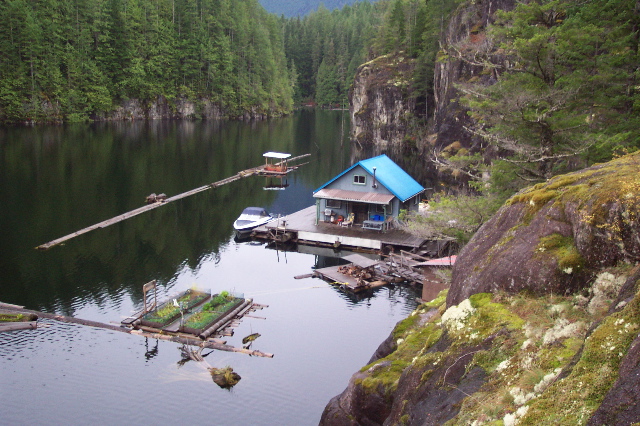 That's the spare engine ('kicker') on our original Hourston, shown below (just like the mod proposed for our Piper Arrow).

View from center of lower portion of Powell Lake, looking north. At the northernmost point of the visible water is our cul-de-sac (officially called Hole-in-the-Wall). The lake continues much further north past Hole-in-the-Wall, between the mountains, opening up into large lake extensions to the north (top right) and east (far right). The marina (last sign of civilization) is to the lower left (southwest) in this photo, about 20 minutes speedboat time to Hole-in-the-Wall.
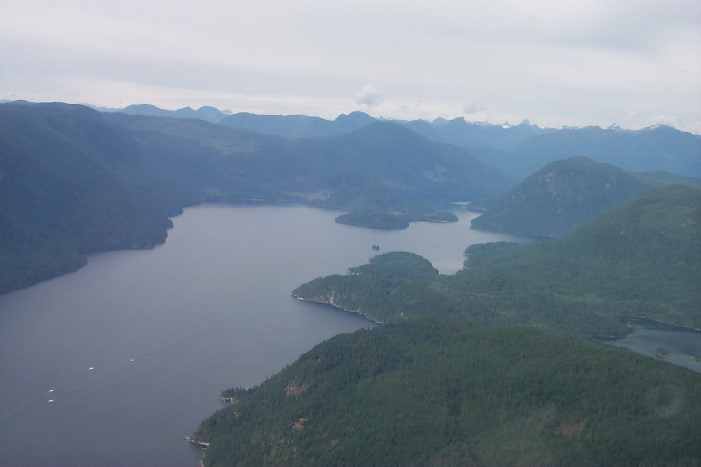
This unique lake environment can be simulated via a 360-degree virtual tour view from the Powell Lake Marina. This 360-degree view was photographed on a dreary winter day -- no promises if it crashes your software -- CLICK HERE
While the purchase of our float cabin was in progress, we stayed a few days in our tent on the deck before the deal was final. The interior is basic, with propane stove and solar panels for limited electricity. A fireplace provides heat. Water is from a hand pump at the sink. An overhead loft gives you a bedroom with quite a view.
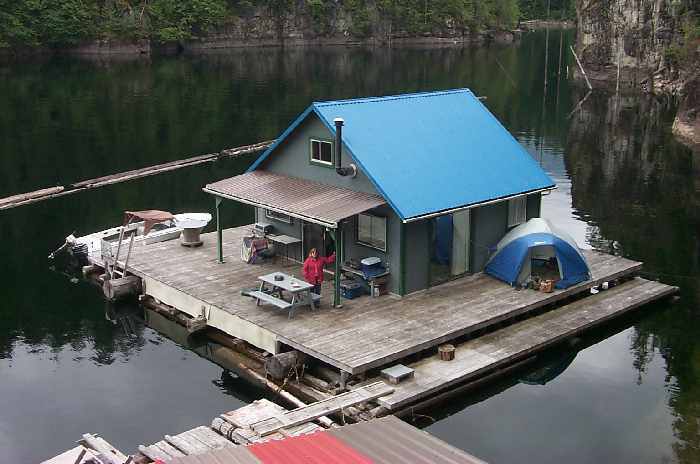
The land-based shed is where you store your valuables when you leave. It's just above the lake's high-water line. The law of the land is that you leave your cabin unlocked (tough to get used to when you're from L.A.), and your neighbors stop by in their boats occasionally to make sure that all is okay (or to borrow a propane tank in an emergency). But valuables (tools!) can be locked in your shed. The cabin bobs just a bit in the wake of passing boats or storms (barely noticeable) but raises and lowers with changes in water level while tethered to land by heavy-duty cabin-to-shore cables.
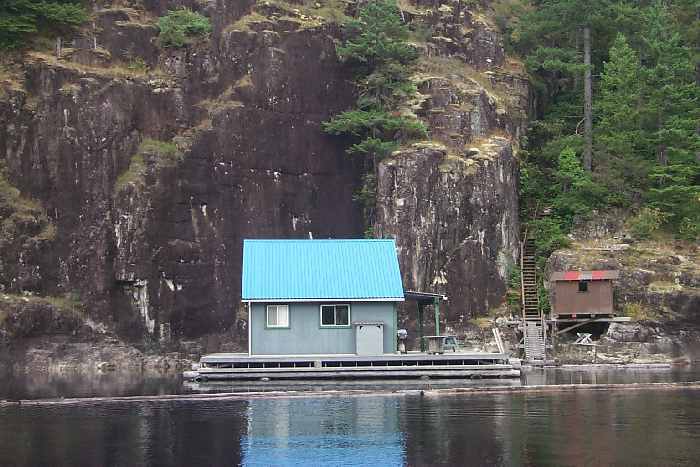
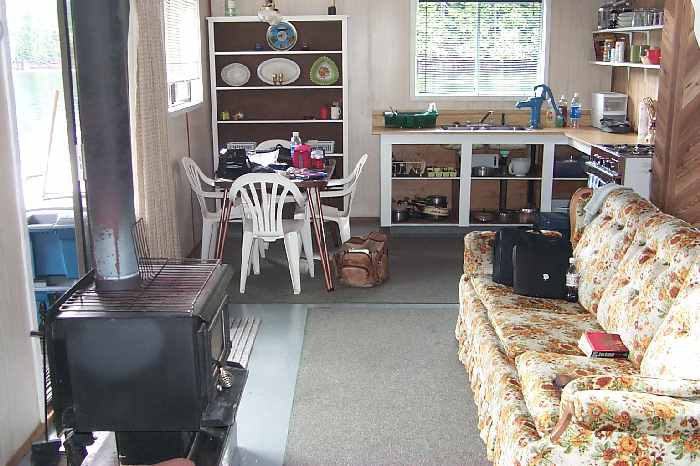
Some float cabin history....
There isn't a lot documented on this subject, since the locals tend to keep this subject a guarded secret. Don't want any of those pesky Americans tourists, you know. But here's what seems to be the situation... Most (except at least one!) of these float cabins (about 200 total) are owned by local residents. Many work in the nearby paper mill or as lumberjacks or in other local trades. Our cabin is mid-size and one of the newest on the lake -- it was constructed in the late 1990's approximately 3 miles from today's location and towed to the current site. The rustic look is intentional -- this cabin has personality. The float structure is exceedingly important, and our float was built right by an accomplished craftsman who built the float and cabin nearly single-handed. Older floats start to sink as the logs become waterlogged and need to be upgraded (buoyant plastic floats are added). Some of these cabins date back to the 1930's (maybe earlier). Most of the residents of the floats are part-time, some commuting to work in town daily via boat, but most use their floats as weekend getaways. The marina is a busy place on Friday evening. This is a working lake -- that is, other than the float cabins, it is a lumber transportation system. Major logging operations put floating logs in the lake, herded south for extraction. It's not unusual to find an escaped log suddenly in the path of your 70 HP Merc on a rainy day with low visibility. It's a good place for attention to your driving, and a satellite phone makes us much more comfortable. A routine sight is a tugboat hauling a huge barge with tractor trailers and heavy-duty logging equipment to/from the logging work sites. And the lumberjacks need water transport too -- these commercial boats run day and night through all conceivable weather (radar equipped). Don't get in their way! The lake is large (about 25 miles long and 10 miles wide), with five major arms. The shape of the lake keeps you always within site of land except in extremely low visibility, and there are some very remote locations. Our float is in a cove (Hole-in-the-Wall) that is exceptionally well protected and with a larger population of floats than is typical. A recent government moratorium restricts any additional float cabins, and there are very few land cabins due to government ownership of the lake and surrounding forests. Recent government regulations (not taken kindly by local residents) eliminates some of the previous on-shore pit toilets for environmental reasons and requires replacement by on-float chemical toilets. As a float cabin resident, you do not own any of the land (it's government crown property), but your float may have a few on-land features (storage shed) that is not of concern to the government. You lease your water rights, but that's a bit tricky for U.S. citizens since it is Canadian waters. We had to form a Canadian numbered corporation with a Canadian lawyer as the president of our board of directors. That made it legal for us to be there, and absolutely everyone has made us feel extremely welcome. We get lots of kidding (we're city-folk, you know), but there has been nothing but support and friendship of the most personal kind. While we are gone, there are lots of new friends checking on our float and helping us with projects. The previous owner of the cabin has become our dear friend, and he assists us with major projects and keeps everything airworthy while we're away. All-in-all, this is one of life's experiences that is particularly unique. Just call us 'floaters'. Here's our Current Designs Libra XT kayak -- that's me and our friend John Maithus in the kayak. We're test driving the new kayak on New Years Day 2001, with John and his famous dog 'Bro' spending the holiday on our float. So you see that the lake does not freeze in winter (but the air drops below freezing). If you see a chain saw in my hands, its merely for special effect. John is a construction genius (he built our float cabin), and he has helped us immensely with personal projects. 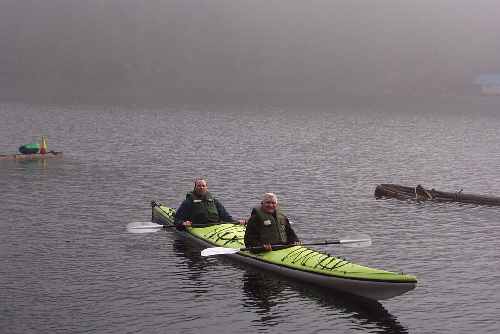 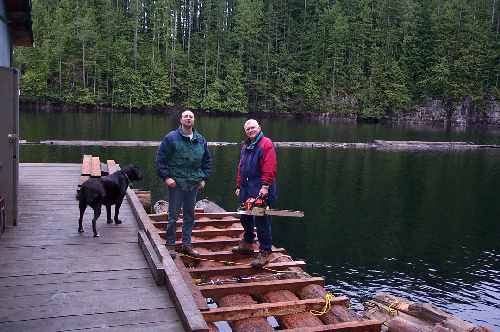 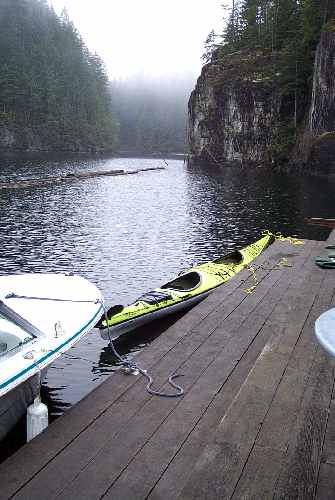 We're convinced that real estate investments in this area are bound to grow. It's one of the few places that you can still buy affordable property with an ocean view. And we need a place in town to get out of the weather -- we learned about winter winds on our float first-hand!. So (and this is, of course, merely rationalization), we bought a condo in town. It is next to the ferry terminal and marina. Our view is of the ferry terminal and all the way out to Vancouver Island in the distance. Now there's a second boat in the nearby ocean harbor (a short walk) for exploring the local coast. For a 360-degree view from the roof of our condominium complex, you can access a view that will rotate and show our specific condo unit (top floor, second unit from the far right). But it just might be too much for your computer to process (so no promises) -- CLICK HERE |

